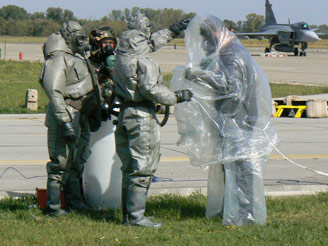Preparing first responders for CBRN incidents
Chemical, biological, radiological and nuclear (CBRN) weapons are among the most dangerous weapons in the world. Several terrorist groups have actively sought weapons of mass destruction as they can cause a higher mortality than conventional weapons. It is important to ensure that first responders are prepared for such eventualities and that decision makers get timely scientific and operational CBRN information to protect populations.

In order to effectively manage the consequences of CBRN incidents, a training course for first responders took place at the Joint CBRN Defence Centre of Excellence in Vyškov, Czech Republic on 12 November 2014. Thirty military and civilian participants from consequence-management structures in Azerbaijan, Moldova, Ukraine and NATO countries attended the course entitled “Consequence Management after CBRN Incident”.
The main aim of the course was to ensure that first responders such as police officers, fire fighters and paramedics have a common knowledge base and a basic level of preparedness when responding to CBRN incidents. Blending theory with practice, the course focused on helping countries improve their civil emergency plans and looking at how NATO, the European Union and other international organisations organise their consequence-management systems. The 2011 Fukushima nuclear power plant incident, for instance, was closely examined, and experts who helped deal with the incident also participated in the course.
Dealing with the recovery

“A lot of people will be affected and a lot of subjects will be dealing with the recovery,” said Captain Gorazd Stergar, CBRN defence course instructor at the JCBRN Defence COE. “And for this we need to be ready. This course provided opportunities on how and where to find possible solutions; each CBRN incident is unique,” he added.
Consequence management is a national responsibility and each country is responsible for handling emergencies that occur within its own territory. However, responding to CBRN incidents involves many organisations and agencies as no single civil or military agency possesses the capacity and expertise to handle the many complex issues alone that may arise in response to CBRN incidents.
Promoting security
The co-director of this project is Colonel Mariana Grama, Ministry of Defence of the Republic of Moldova, whose country is facing security issues in this area. “There are many vulnerable CBRN facilities that are lacking physical protection and presenting a high risk for our national security, public health and environment,” said Colonel Grama. “There is also an increase of CBRN agents imported in the country or transited through our territory and we are dealing with instability in bordering countries, in particular with Ukraine,” she continued.
In the future, Colonel Grama hopes that she will be able to integrate what has been learnt into their national crisis-management planning. “It will be easier and more efficient to improve interoperability between response teams at national and international levels and to review and enhance operational CBRN plans and actions in the country with the integration of international standards and procedures, especially EU and NATO ones,” explained Colonel Grama.
With regard to greater coordination, Ukrainian Security Service officer Andrii Vasylyshyn, who attended the course, stated: “Today’s ongoing globalisation processes are changing the nature of warfare together with the increasing threat from global, networked, decentralised and outsourced terrorist groups who are prepared to use CBRN materials no longer as a means to achieve political objectives but as an end in itself.” He added, “there is a growing need to protect society from potential future scenarios in which CBRN materials might be deployed by unconventional means of delivery. This will require cooperation between governments, counter-terrorism officials and counter-proliferation agencies.”
Sharing information on CBRN threats and risks
In addition to this training course, the JCBRN Defence Centre also inaugurated on 12 November NATO’s first CBRN reachback capability. “It provides timely scientific and operational CBRN expertise, assessments and advice to NATO commanders and their staff across the full spectrum of operations,” said Jamie Shea, NATO Deputy Assistant Secretary General for Emerging Security Challenges.
The operations room located at the JCBRN Defence Centre will allow NATO commanders to protect deployed forces and provide experts with CBRN advice to help protect the civilian populations of member countries. In short, it will enhance NATO’s CBRN preparedness and first response capability.
“A comprehensive information-gathering system and informed assessment are essential aspects of intelligence and CBRN defence,” said Colonel Jiri Gajdos, JCBRN Defence COE Director.This is crucial for a reliable assessment of activities, as experienced during the CBRN misuse by terrorists groups in Northern Africa and the Middle East, or the consequences of industrial incidents such as those in Chernobyl or Fukushima.
The operations room is already able to respond to national and NATO requests for information on a 24/7 basis and can easily shift to operations mode, should a crisis emerge. Its set-up is inclusive of both military and civilian consequence-management authorities.
The requirement for CBRN reachback is one of the lessons learned from NATO operations and has been identified as a critical capability for future operations in a potential CBRN environment.
The course is funded under the NATO Science for Peace and Security (SPS) Programme and the operations room is sponsored by NATO’s Defence against Terrorism Programme of Work (DAT PoW), which aims to mitigate critical capability shortfalls of the Alliance.
